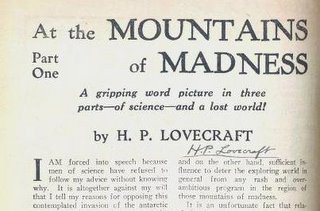As frequent HPLblog readers know, I've been slowly exporing whether Lovecraft was explicitly being watched and recruited by Houdini. Yes, Chrispy knows there is no smoking gun, and ... yet ... the circumstantial evidence is tantalizing.
As I uncover more "clues" I will post them. One must still diligently sort through annecdotes and memories and apocryphal stories !
This excellent site via Lars Klores, has some interesting new points of consideration.
J.C. Henneberger began Weird Tales in March of 1923 "to give the writer free rein to express his innermost feelings in a manner befitting great literature". From the beginning, it was clear that the magazine existed in its own abyss ... Poets and authors who favored the darker side, dream-spinners and troubled souls seeking an outlet, found one in its pages. Henneberger, a journalist who had steeped himself in the dark, southern fantasies of Poe for much of his life, began by hiring well-known Chicago author Edwin Baird to serve as Weird Tales’ editor, assisted by Farnsworth Wright and Otis Adelbert Kline. The pulp (cheap pulpwood paper it was printed on) struggled under Baird’s editorship and was uneven, and uninspired.A discovery under Baird’s editorship was ... H.P. Lovecraft. While Baird purchased almost everything Lovecraft submitted, Henneberger has claimed that Baird disliked Lovecraft’s fiction and only purchased the stories under Henneberger’s orders. Baird’s rejection of similarly promising material (such as Greye La Spina’s classic, "Invaders from the Dark") would seem to bear this out. According to author E. Hoffmann Price, "Baird was an idea man. Once the idea was going, he swiftly lost interest in it."{Elsewhere - search blog - we learn that Henneberger desperately wanted HPL to replace Baird as editor}
After 14 issues of uneven quality, Henneberger replaced Baird with Farnsworth Wright, who until then had served as the pulp’s chief reader of manuscripts. Wright, was a tall, gaunt man afflicted with Parkinson’s Disease.So, here are two "clues". Henneberger quickly decided baird was not his man. Wright had Parkinson's - though he lasted for years as editor - and perhaps Henneberger was concerned over this issue?
The bigger element is the annecdote that Henneberger forced Lovecraft onto Baird. From all historical perspectives, Henneberger and Lovecraft were not close, but starting shortly after the magazine's inception, Henneberger desperately grasped for Lovecraft.
Weird Tales starts in 1923.
Houdini is a major player (but how? Just writing stories or more?) in Weird Tales from almost the inception.
C M Eddy meets HPL in August {much much more about this in future blogs posts}.
Henneberger/Houdini contracts a ghost-writing assignment for an astounding sum of cash.
Then, Henneberger decides he wants HPL as editor and woos him.
Frank Belknap Long is a witness to this.
Houdini invites HPL to his house, and then to a performance.
Houdini writes HPL that he will make intorductions for him to get jobs.
C M Eddy makes a few trips to NY - to see Houdini and to see HPL.
HPL does turn down editorship of Weird Tales.
More Houdini work comes to C M Eddy and Lovecraft including Cancer of Superstition.
Prior to Houdini's death, C M Eddy, HPL, and the Houdinis have dinner and Bess is poisoned.
HPL is invited to come with Houdini to be on stage - declines.
Houdini dies - or is he assasinated?
Again, very tantalizing coincidences.
However, contra we have devilishly little evidence to connect the dots from the writings of Muriel Eddy and Lovecraft's correspondents or research from S T Joshi, or L Sprague de Camp.
Stay tuned!

















































